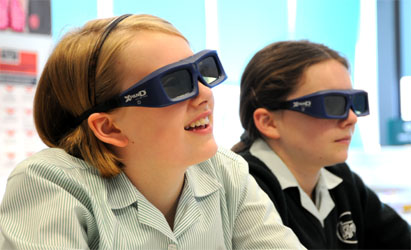How 3D Lessons Improve Student Learning
A research compares the difference in comprehension, information retention and overall behaviour between students learning via traditional 2D methods versus learning via 3D projection. It was conducted in classrooms across seven European countries.
Texas Instruments (TI) DLP Products presents the research data that shows 3D, when used as a teaching tool in classrooms, has a widespread positive impact on how students learn.
The independent study is announced today, Sept. 29, at a UK launch event hosted in collaboration with The Company of Educators, which has been founded within the philanthropic tradition of the City of London livery companies.
[ Also Read: LG and Gameloft Host 3D Gaming Tournament ]A long-time partner in providing technology for education, DLP Products initiated the study as a way to gather information and feedback on teaching with content displayed using 3D projectors.
The research team, led by Professor Anne Bamford, Director of the International Research Agency, commissioned pre- and post-testing on control and variable student groups to track information retention and understanding, as well as collected observational data during classroom visits to measure student attentiveness and behaviour.
[ Also Read: Netflix Streaming on Nintendo 3DS Hand-Helds ]Highlights from the survey include:
- On average, 86% of pupils improved from the pre-test to the post-test in the 3D classes, compared to 52% who improved in the 2D classes.
- Individuals improved test scores by an average of 17% in the 3D classes, compared to an 8% improvement in the 2D classes between pre-test and post-test.
- 92% of students on average were attentive during 3D lessons, while only 46% were actively paying attention during non-3D lessons.
The research project involved 740 students (ages 10-13), 47 teachers and 15 schools across France, Germany, Italy, Netherlands, Turkey, United Kingdom and Sweden between December 2010 and May 2011.
Students were tested before and after the lessons, with one control group learning with 2D methods only, and the other receiving the same instruction, but with 3D content added into the lessons.
Students were also tested on their ability to recall the information four weeks later, and researchers collected observational data on the engagement level of students at set intervals during each of the lessons.
[ Also Read: LG Mobile Highlights the Future of 3D Technology ]“At Texas Instruments, we work to provide technology that improves people’s lives and the results of this study show that we’re putting our resources in the right place,” said Roger Carver, manager of Front Projection, DLP Products.
Since 1996, Texas Instruments’ DLP display technology is being offered for projectors and displays. The technology spans movie theaters (DLP Cinema) and large-scale, professional venues; in conference rooms, classrooms, and home theaters; and with DLP Pico-enabled mobile devices, the ability to project images from the palm of your hand.
Photo courtesy: Texas Instruments DLP




